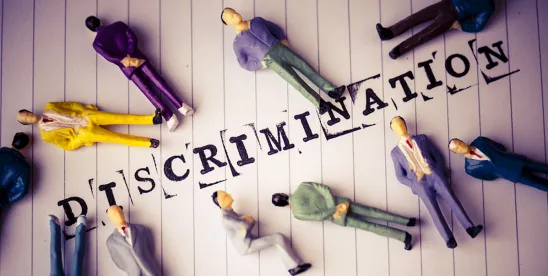On April 23, 2025, President Trump signed Executive Order 14281, Restoring Equality of Opportunity and Meritocracy (the “EO”).
This EO states its purpose as a solution to claims of employment discrimination based on “disparate-impact liability,” characterized as a “key tool” of a “pernicious movement” that threatens the foundation of the American Dream. The EO states a policy goal of eliminating “the use of disparate-impact liability in all contexts to the maximum degree possible” and includes numerous provisions that will affect federal agency enforcement priorities and may influence employer practices.
This Insight explains the concept of disparate impact liability, analyzes the EO and its directives, and provides practical considerations for employers.
What Is Disparate Impact Liability?
In 1971, the Supreme Court of the United States (SCOTUS) recognized in Griggs v. Duke Power Co. that Title VII of the Civil Rights Act of 1964 (“Title VII”) “proscribes not only overt discrimination but also practices that are fair in form, but discriminatory in operation.” Practically speaking, SCOTUS thus gave its imprimatur to claims where there was a statistically significant showing that a practice or policy adversely impacted a protected class, even though the practice or policy appeared fair or neutral on its face. Congress codified the burden of proof in disparate impact cases at 42 U.S.C. § 2000(e)-2 (k), when it passed the Civil Rights Act of 1991.
In 2009, a divided SCOTUS decided Ricci v. DeStefano, addressing whether an employer that engages in “disparate treatment” can justify doing so to avoid “disparate impact” liability. The majority held that an employer may do so only if it can prove its reasoning under a “strong basis in evidence” standard. In a concurring opinion, Justice Scalia foreshadowed current events, writing that “the war between disparate impact and equal protection will be waged sooner or later. . . .” Justice Ginsburg argued in a dissent that neither Congress’s statutes nor Court precedent offered “even a hint of ‘conflict’ between an employer’s obligations under the statute’s disparate-treatment and disparate-impact provisions. . . .”
The EO’s Characterization of “Disparate Impact”
The EO describes disparate impact liability as “a near insurmountable presumption of unlawful discrimination [that] exists where there are any differences in outcomes in certain circumstances among different races, sexes, or similar groups, even if there is no facially discriminatory policy or practice or discriminatory intent involved, and even if everyone has an equal opportunity to succeed.” It does not mention that the different outcomes must be statistically significant to require an employer to show business necessity—or, in the case of age, reasonable factors other than age—for the employment practice at issue. The EO goes on to state that “[d]isparate-impact liability “all but requires individuals and businesses to consider race and engage in racial balancing to avoid potentially crippling legal liability” and concludes that disparate impact liability is unconstitutional. The administration’s position is that equal treatment of all citizens is a bedrock principle of the United States and that this principle “guarantees equality of opportunity, not equal outcomes.”
How the EO Seeks to Diminish Disparate Impact Liability
No executive order can rewrite a statute, overrule case law, or authoritatively declare what is and is not constitutional. Thus, the legal impact of the EO on a lawsuit brought by a private plaintiff is de minimis, at best.
The EO, however, establishes three clear, tangible directives as to what the enforcement policy of the Trump administration will be with respect to Title VII and other anti-discrimination laws. These directives are as follows:
1. Federal Agencies Required to Assess Policy and Practices
The EO directs all agencies to take these concrete actions:
- De-prioritize enforcement of any statutes and regulations related to disparate impact liability, including, but not limited to, the aforementioned provision of Title VII.
- By May 23, 2025 (45 days after the issuance of the EO), in conjunction with the U.S. Attorney General, submit a report on:
- an inventory of existing regulations, guidance, rules, and orders that “impose disparate-impact liability or similar requirements”;
- a plan to amend or repeal such provisions; and
- “other laws or decisions, including at the State level, which impose disparate-impact liability and any appropriate measures to address any constitutional or other legal infirmities.”
- By July 22, 2025 (90 days after the issuance of the EO), review “all existing consent judgments and permanent injunctions that rely on theories of disparate-impact liability” with a view toward taking any legal action consistent with the administration’s policy.
2. Equal Employment Opportunity Commission (EEOC) and Department of Justice (DOJ) to Lead EO Compliance
EEOC Acting Chair Andrea Lucas and the Attorney General are directed to do the following:
- By June 7, 2025, assess all pending investigations, civil suits, and other matters that “rely on a theory of disparate-impact liability” and “take appropriate action with respect to such matters . . . .” Note that this directive extends to heads of other federal agencies, including the Federal Trade Commission, the Consumer Financial Protection Bureau, and the Department of Housing and Urban Development.
- “Jointly formulate and issue guidance or technical assistance to employers regarding appropriate methods to promote equal access to employment regardless of whether an applicant has a college education” (emphasis added).
3. Attorney General to Examine Conflicts with State and Local Laws
The EO also directs the Attorney General, in coordination with other agencies, to “determine whether any Federal authorities preempt State laws, regulations, policies, or practices that impose disparate-impact liability based on a federally protected characteristic such as race, sex, or age, or whether such laws, regulations, policies, or practices have constitutional infirmities that warrant Federal action, and shall take appropriate measures consistent with the policy of this order.”
What This EO Does (and Doesn’t Do)
It must be emphasized that, while this EO represents the present administration’s enforcement priorities and interpretation of Title VII and related equal opportunity laws, it does not change the law for most employers. Unlike prior executive orders that eliminated requirements for federal contractors and rescinded other long-standing federal policies, this EO does not revoke prior executive orders.[1] Nevertheless, it represents a shift in enforcement priorities that sharply contrasts with those of prior administrations.
As we have previously reported, EEOC Acting Chair Lucas has made her positions and priorities clear through numerous actions, publications, and statements, including prepared remarks she read at a conference in May 2024, titled “The Future of DEI, Disparate Impact, and EO 11246 after Students for Fair Admissions v. Harvard/UNC.” Likewise, on February 5, 2025, Attorney General Pam Bondi issued a Memorandum to all DOJ employees, advising them to revise all departmental materials and guidance to “narrow the use of ‘disparate impact’ theories.”
Further, even though President Trump has removed EEOC Commissioners and not yet nominated replacements (thus leaving the EEOC without a quorum and technically unable to issue technical assistance or new regulations), Acting Chair Lucas and the DOJ have already issued joint guidance aligned with the President’s earlier executive orders. These agencies can be expected to comply with this EO’s directive to publish new guidance regarding “appropriate methods to promote equal access to employment regardless of whether an applicant has a college education.”[2] How this will be accomplished remains to be seen.
The shift in enforcement priorities may affect ongoing cases initiated or joined under prior administrations. For example, a question of disparate impact is central to current litigation in the novel realm of artificial intelligence (AI) and its effects on workplaces. In one notable ongoing case, claims that arose from the use of automated selection tools include a cause of action based on disparate impact under Title VII. Whether the EEOC will withdraw or amend its prior filings in this or other pending cases is among the many questions raised by the EO.
Further, while the EO mentions the word “age,” it does not mention “disability” or cite to either the Age Discrimination in Employment Act (ADEA) or the Americans with Disabilities Act (ADA). It seems unlikely that, given the EO’s clear position rejecting the disparate impact theory of discrimination, this administration will want to continue an investigation or litigation premised on a disparate impact theory in violation of the ADEA or the ADA. Accordingly, employers may likewise be able to get the EEOC or DOJ to stop investigations of such claims.
State and Local Laws Preempted?
Another potentially significant issue raised in the EO creates the specter of conflict with state and local jurisdictions. The EO directs the Attorney General to work with other agencies to search for “constitutional infirmities” in any “[s]tate laws, regulations, policies, or practices that impose disparate-impact liability based on a federally protected characteristic such as race, sex, or age.”
Indeed, numerous jurisdictions have adopted—or are currently considering—laws that rely on disparate impact theory to prohibit discrimination. For employers, a significant and growing body of law regulating the use of AI in employment-related decision-making tools (as well as consumer protection laws) requires a disparate impact analysis to ensure the use of such systems does not result in disparate selection outcomes. Some laws also obligate employers to report the results of such analyses publicly or to state regulatory agencies.
Practical Implications for Employers
The EO should not signal to employers that they must immediately stop analyzing potential outcomes of employment decisions and cease conducting adverse impact analyses, particularly in appropriate contexts, such as layoffs or reductions in force (RIFs). Prudence dictates that it may now be more important than ever to exercise due caution and consult with counsel to ensure that any analysis or use of adverse impact analysis is conducted appropriately, lawfully, and under attorney-client privilege, to the extent possible.
Employers should recognize that the EO is an expression of Executive Branch policy, clarifying that the administration will not recognize claims or pursue investigations, administrative enforcement actions, or litigation based on disparate impact theories of liability. This does not foreclose all liability under federal (or state or local) law, as the EO does not obviate the risk of disparate impact-type claims being asserted in civil litigation.
Moreover, statistical adverse impact analysis is used for many purposes in various contexts. For example, in the case of RIFs, it is merely a risk measurement tool used to assess whether a potential discrimination litigation risk exists based on the foreseeable outcomes of an employer’s layoff selection criteria and process.
That said, the EO highlights the danger of misusing disparate impact analysis as the basis for making employment decisions in order to achieve balanced representation of employees in protected categories. Employers must take care to consult with knowledgeable employment counsel to ensure that disparate impact analysis is utilized in a legally appropriate manner and performed in a way that reduces, rather than increases, the risk of potential discrimination claims.
What Employers Should Do Now
While Title VII and other federal equal opportunity laws remain unchanged, employers must understand that the shift in the current administration’s priorities is likely to result in changes to how federal agencies will enforce Title VII and other equal opportunity laws. To be prepared, employers should consider doing the following:
- If you are a party to an existing disparate impact claim before a federal agency—including recently settled or disposed matters—consider whether further action may be warranted in light of the EO’s directive to cease prosecuting adverse impact claims and to evaluate existing consent judgments and permanent injunctions that relied on disparate impact analysis.
- Consider the impact of the EO on pending civil litigation and the viability of claims based on disparate impact theory. Assess whether any action might be taken to settle or dismiss such claims or causes of action.
- Remain alert for the issuance of further guidance from the EEOC and the DOJ, as well as the removal or revision of existing materials.
- Be aware that the EO heightens the level of awareness and sensitivity on the concept of “disparate impact,” which, in turn, elevates the importance of conducting disparate impact analyses under the attorney-client privilege. Therefore, if an adverse impact analysis is to be performed, strongly consider proceeding only after consulting knowledgeable employment counsel to identify potential discrimination litigation risks, avoid misusing impact analysis that could yield arguably discriminatory decision-making, and ensure compliance with applicable law barring employment decisions based on legally protected categories, such as race, sex, national origin, or age.
ENDNOTES
[1] To the extent that the EO purports to amend existing regulations (without adherence to the Administrative Procedures Act that generally governs federal rulemaking), those regulations apply to entities that receive federal financial assistance from the DOJ under Title VI—not Title VII—of the Civil Rights Act of 1964.
[2] Educational status is not a protected class under federal law. The discriminatory effects of educational achievements as prerequisites for employment were at issue in Griggs, the 1971 case codified in the 1991 legislation on “Disparate Impact.”
Elizabeth A. Ledkovsky contributed to this article









 />i
/>i
